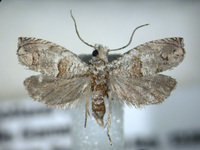Identification
Adult Markings: The following description is based on that of Heinrich (1923) and Wright and Gilligan (2023). This is a relatively small species of Epiblema (mean FWL = 5.5 mm) with a relatively broad forewing. The head and palps are mostly white, but the lateral surface of the second segment of the labial palp is tan. The vertex has a mixture of tan and white scales, and the dorsal surface of the scape varies from tan to grayish-white. The forewing is white with brown fasciate markings and brown transverse reticulations. A pale-brown basal patch is present on the basal third that extends from the inner margin inward to just beyond the middle of the wing. The patch is overlaid with three or four dark brown reticulations, and the outer margin is somewhat irregular. The central region of the wing has a vaguely defined whitish band that extends from the inner margin to the costa. The costa is evenly and conspicuously strigulated with narrow fuscous dashes from the base to the apex. A thin postmedian fascia is present before the ocellus. The ocellus has three pinkish to grayish components that include a proximal band, an apical quadrant, and a tornal quadrant, with the latter two separated by a blackish-brown longitudinal dash. The termen has a narrow salt-and-pepper colored band from the tornus to the apex, and the cilia are white and dusted basally with fuscous. The hindwing is smoky fuscous, and the cilia is whitish with dark shading on the basal and terminal portions. The legs are fuscous and banded with white.
Wingspan: 10-14.5 mm (Heinrich, 1923).Forewing Length: 4.9-6.1 mm; mean = 5.5 mm (Wright and Gilligan, 2023).
Adult Structural Features: Wright and Gilligan (2023) have descriptions and illustrations of the male and female genitalia.
Adult ID Requirements: Identifiable from good quality photos of unworn specimens.
Immatures and Development: The larval life history is undocumented.

 »
»


 »
»
